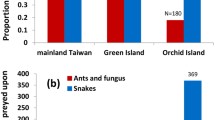Synopsis
The neotropical Pacific wrasse, Thalassoma lucasanum, forms groups of 30 to 300 individuals that overwhelm the defense of embryos by the Pacific sergeant major, Abudefduf troschelii, and thereby gain access to a food resource from which solitary individuals are effectively excluded by paternal defense. The duration of feeding by the wrasse groups and the fraction of embryos eaten in a nest are positively correlated with group size. The benefit of group foraging is probably derived from a reduction in the frequency with which group members experience attack by defending sergeant majors, as reflected in the positive correlation of group size with feeding duration. Large foraging groups only form when sergeant major embryos are present in nests, indicating that this is a primary benefit of participation in these groups for this wrasse. In contrast, in the Caribbean large foraging groups of the congeneric bluehead wrasse, T. bifasciatum, fail to form despite the presence of defended embryos of the Caribbean sergeant major, A. saxatilis. This might be due to the relatively low population densities of the Caribbean wrasse in comparison to those of the Pacific wrasse or to the relatively low densities of Caribbean sergeant major nests containing embryos at any time.
Similar content being viewed by others
References cited
Albrecht, H. 1969. Behavior of four species of Atlantic damselfishes from Columbia, South America, Abudefdif saxatilis, A. taurus, Chromis multilineata, C. cyanea; Pisces Pomacentridae. Z. Tierpsychol. 26: 662–676.
Alevizon, W.S. 1976. Mixed schooling and its possible significance in a tropical western Atlantic parrotfish and surgeonfish. Copeia 1976: 796–798.
Barlow, G.W. 1974. Extraspecific imposition of social grouping among surgeonfishes (Pisces: Acanthuridae). J. Zool. Soc. Lond. 174: 333–340.
Bullis, H.R. & R. Juhl. 1967. Phalanx orientation in feeding behavior of the little tuna, Euthynnus alleteratus. Trans. Amer. Fish. Soc. 96: 122–125.
Crook, J.H. 1965. The adaptive sigificance of avian social organizations. Symp. Zool. Soc. Lond. 18: 237–258.
Cummings, W.C. 1968. Reproductive habits of the sergeant major, Abudefduf saxatilis (Pisces, Pomacentridae) with comparative notes on four other damselfishes in the Bahama Islands. Ph.D. Dissertation. University of Miami, Coral Gables. 184 pp.
Fink, B.D. 1959. Observations of porpoise predation on a school of Pacific sardines. Cal. Fish Game 45: 216–217.
Foster, S.A. 1985a. Group foraging by a coral reef fish: A mechanism for gaining access to defended resources. Anim. Behav. 33: 782–792.
Foster, S.A. 1985b. Size-dependent territory defense by a damselfish: a determinant of resource use by group-foraging surgeonfishes. Oecol. 67: 499–505.
Foster, S.A. 1987. Diel and lunar patterns of reproduction in the geminate Caribbean and Pacific sergeant major damselfishes: Abudefduf saxatilis and A. troschelii. Mar. Biol. (in press).
Glynn, P.W. 1972. Observations on the ecology of the Caribbean and Pacific Coasts of Panama. Bull. Biol. Soc. Wash. 2: 13–30.
Krebs, J.R. 1973. Social learning and the significance of mixedspecies flocks of chickadees (Parus spp.). Can. J. Zool. 51: 1275–1288.
Martinez, D.R. & E. Klinghammer. 1970. The behavior of the whale Orcinus orca: a review of the literature. Z. Tierpsychol. 27: 829–839.
Montgomery, W.L., T. Gerrodette & L.D. Marshall. 1980. Response of algal communities to grazing by the yellowtail surgeon fish, Prionurus punctatus in the Gulf of California, Mexico. Bull. Mar. Sci. 30: 477–481.
Pitcher, T.J., A.E. Magurran & J.R. Allen. 1983. Shifts of behaviour with shoal size in cyprinids. pp. 220–228. In: Third Brit. Freshw. Fish Conf. Proc., University of Liverpool, Liverpool.
Robertson, D.R., H.P.A. Sweatman, E.A. Fletcher & M.E. Cleland. 1976. Schooling as a mechanism for circumventing the territoriality of competitors. Ecology 57: 1208–1220.
Shaw, E.S. 1955. The embryology of the sergeant major Abudefduf saxatilis. Copeia 1955: 85–89.
Thomson, D.A., L.T. Findley & A.N. Kerstitch. 1979. Reef fishes of the sea of Cortez. John Wiley and Sons, New York. 302 pp.
Vine, P.J. 1974. Effects of algal grazing and aggressive behavior of the fishes Pomacentrus lividus and Acanthurus sohal on coral reef ecology. Mar. Biol. 24: 131–146.
Warner, R.R. & S.G. Hoffman. 1980. Local population size as a determinant of mating system and sexual composition in two tropical marine fishes (Thalassoma spp.). Evolution 34: 508–518.
Zar, J.H. 1984. Biostatistical analysis. Prentice-Hall, Englewood Cliffs. 718 pp.
Author information
Authors and Affiliations
Rights and permissions
About this article
Cite this article
Foster, S.A. Acquisition of a defended resource: a benefit of group foraging for the neotropical wrasse, Thalassoma lucasanum . Environ Biol Fish 19, 215–222 (1987). https://doi.org/10.1007/BF00005350
Received:
Accepted:
Issue Date:
DOI: https://doi.org/10.1007/BF00005350




